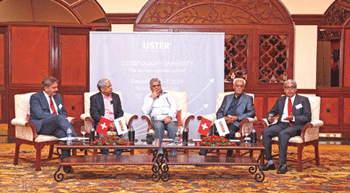
Uster event discusses pathways to prosperity
India´s textile producers have a clear picture of the challenges they face, and a determination to make the improvements needed along the pathways to future prosperity.
India´s textile producers have a clear picture of the challenges they face, and a determination to make the improvements needed along the pathways to future prosperity. That was the message from the three-day USTER®QUALITY UNIVERSITY 2014 event, held in Goa recently. The industry is crucial to the national economy and cotton is the dominant fiber. With activities across the entire textile value chain, India is focused on improving competitiveness through economies of scale and quality-enhancing measures from cotton field to finished fabric. Special attention is aimed at raw cotton harvesting and ginning, to reduce contamination. Greater automation in manufacturing, increased use of yarn quality control technology and international market targeting are among key priorities.
USTER´s second Quality University attracted 24 high-level participants, including owners and directors of 19 mills from Gujarat, one of India´s most important textile regions. The theme of the event, from December 5-7, was ´Opportunities and challenges for the Indian textile industry´. Delegates discussed the major issues for the industry´s future prosperity, with a panel of experts offering valuable insights.
Multi-faceted improvement plans
The panel, invited by Uster Technologies, Switzerland and its Indian office, comprised: Dr Anil K Sharma, Director, Ahmedabad Textile Industries Research Association (ATIRA); Ashok K Sharma, Director, Alliance Technocrats Pvt Ltd; Kaushik Dave, Managing Director, Gujarat Hyspin Pvt Ltd; and Thomas Nasiou, Head of Textile Technology, Uster Technologies. The discussions were moderated by VR Rathnam, Head, Uster Technologies India. Panelists outlined their views on raw material issues, manufacturing and yarn trends. Rather than one major problem, the areas acknowledged as requiring improvement cover several aspects of the industry´s activities, and a number of projects are already tackling some of these. Even in an age ruled by technology, it was stressed that human factors were still critical for success in Indian textiles.
Challenges along the entire value chain
India covers every stage of the textile value chain, providing employment for a large share of the nation´s total labor force. Cotton is sure to remain the most important fiber, and the large cotton-growing capacity in India forms a solid basis for the entire sector´s success on global markets. But there should be increased efforts to use this strength as part of an added-value campaign spanning the whole industry, with an emphasis on quality and increased investments in downstream processes such as knitting and finishing. In this way, the industry would achieve greater economies of scale and improve its overall competitiveness internationally.
Tackling cotton contamination
By far the biggest negative for the image of Indian cotton is the continuing problem of contamination, and this topic was discussed extensively at the Quality University. Ginning is only part of the story, but quality here is still falling short of the standards required by spinners. India has more ginning capacity than the industry needs, and even a renewed focus on quality in recent years has made little impact so far. As industry insiders know only too well, trash content has actually been increasing. This tends to lead to lower prices for both the raw cotton and the yarns made from it, and spinners are desperate for a solution, even if it means paying more to the gins for cleaner cottons.
India also has some specific issues, arising from the nature and size of the cotton fields, which make machine-harvesting difficult or impossible in many cases. Hand-picked cotton has the potential for better quality, but often the pickers are unaware of the correct segregation and storage routines to avoid unwanted mixin



